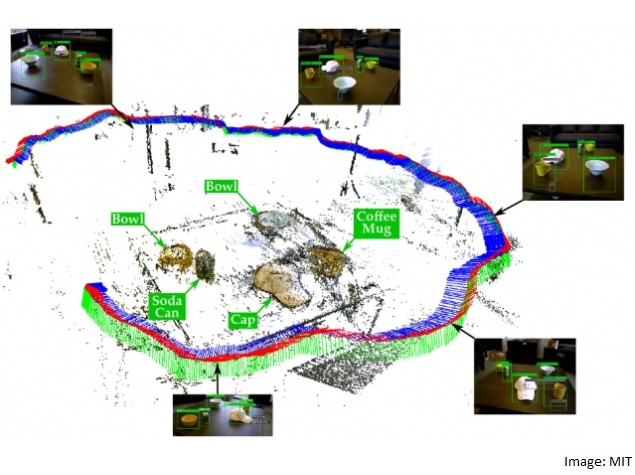- Home
- Science
- Science News
- Soon, Robots to Get Better at Identifying Objects
Soon, Robots to Get Better at Identifying Objects

The researchers at the Massachusetts Institute of Technology's Department of Mechanical Engineering specialises in SLAM, or simultaneous localisation and mapping, the technique whereby mobile autonomous robots map their environments and determine their locations.
The new study demonstrates how SLAM can be used to improve object-recognition systems. The system uses SLAM information to augment existing object-recognition algorithms. Its performance should thus continue to improve as computer-vision researchers develop better recognition software, and roboticists develop better SLAM software.
Since the system can fuse information captured from different camera angles, it fares much better than object-recognition systems trying to identify objects in still images.
According to first author Sudeep Pillai, a graduate student in computer science and engineering at MIT, new object-recognition systems first try to identify the boundaries between objects.
On the basis of a preliminary analysis of colour transitions, they divide an image into rectangular regions that probably contain objects of some sort. Then they run a recognition algorithm on just the pixels inside each rectangle.
A classical object-recognition system may have to redraw those rectangles thousands of times. From some perspectives, two objects standing next to each other might look like one, particularly if they're similarly coloured. Since a SLAM map is three-dimensional distinguishing objects better than single-perspective analysis.
The system devised by Pillai and John Leonard, a professor of mechanical and ocean engineering, uses the SLAM map to guide the segmentation of images captured by its camera before feeding them to the object-recognition algorithm. The SLAM data let the system correlate the segmentation of images captured from different perspectives. Analysing image segments that likely depict the same objects from different angles improves the system's performance. Pillai is now investigating whether object detection can similarly aid SLAM. One of the central challenges in SLAM is what roboticists call "loop closure."
As a robot builds a map of its environment, it may find itself somewhere it's already been - entering a room, say, from a different door, researchers said. The robot needs to be able to recognise previously visited locations, so that it can fuse mapping data acquired from different perspectives. Object recognition could help with that problem.
For the latest tech news and reviews, follow Gadgets 360 on X, Facebook, WhatsApp, Threads and Google News. For the latest videos on gadgets and tech, subscribe to our YouTube channel. If you want to know everything about top influencers, follow our in-house Who'sThat360 on Instagram and YouTube.
Related Stories
- Samsung Galaxy Unpacked 2025
- ChatGPT
- Redmi Note 14 Pro+
- iPhone 16
- Apple Vision Pro
- Oneplus 12
- OnePlus Nord CE 3 Lite 5G
- iPhone 13
- Xiaomi 14 Pro
- Oppo Find N3
- Tecno Spark Go (2023)
- Realme V30
- Best Phones Under 25000
- Samsung Galaxy S24 Series
- Cryptocurrency
- iQoo 12
- Samsung Galaxy S24 Ultra
- Giottus
- Samsung Galaxy Z Flip 5
- Apple 'Scary Fast'
- Housefull 5
- GoPro Hero 12 Black Review
- Invincible Season 2
- JioGlass
- HD Ready TV
- Laptop Under 50000
- Smartwatch Under 10000
- Latest Mobile Phones
- Compare Phones
- iQOO Z10 Turbo Pro
- iQOO Z10 Turbo
- CMF by Nothing Phone 2 Pro
- Motorola Edge 60
- Motorola Edge 60 Pro
- Motorola Razr 60
- Motorola Razr 60 Ultra
- Realme 14T 5G
- HP EliteBook 6 G1a
- HP EliteBook 8 G1a
- Honor Pad GT
- Vivo Pad SE
- Moto Watch Fit
- Honor Band 10
- Xiaomi X Pro QLED 2025 (43-Inch)
- Xiaomi X Pro QLED 2025 (55-Inch)
- Asus ROG Ally
- Nintendo Switch Lite
- Toshiba 1.8 Ton 5 Star Inverter Split AC (RAS-24TKCV5G-INZ / RAS-24TACV5G-INZ)
- Toshiba 1.5 Ton 5 Star Inverter Split AC (RAS-18PKCV2G-IN / RAS-18PACV2G-IN)







![[Partner Content] OPPO K13 - The Undisputed OP Smartphone | Lag Killer Performance | Best in Segment](https://www.gadgets360.com/static/mobile/images/spacer.png)









